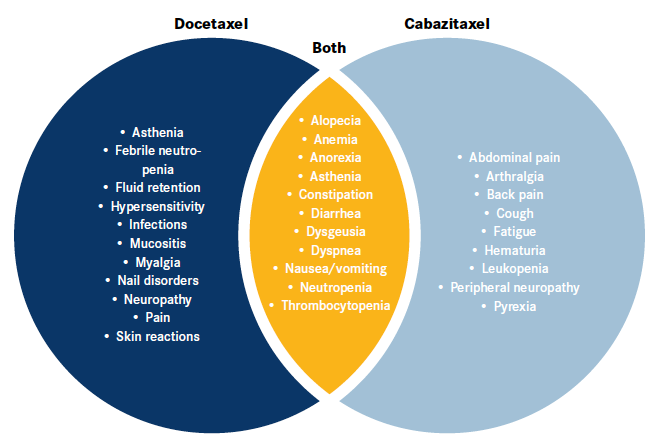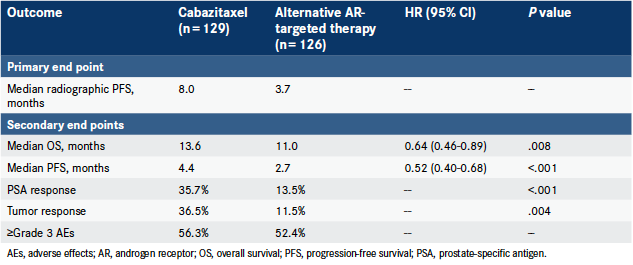Publication
Article
Oncology Live®
Experts Focus on 6 Life-Prolonging Treatments for mCRPC
Author(s):
During a recent OncLive Peer Exchange, a panel of experts in advanced prostate cancer provided their insights on how best to employ 6 therapies that are enabling men with mCRPC to live longer.
Neal Shore, MD

Up to 20% men with advanced prostate cancer will develop castration-resistant prostate cancer (CRPC) within approximately 5 years of follow-up, with more than 84% having metastases at the time of CRPC diagnosis.1 Among those with nonmetastatic CRPC at diagnosis, 33% are likely to develop metastatic CRPC (mCRPC) within 2 years. Despite advances in treating CRPC, 5-year overall survival (OS) remains low (median OS for CRPC, 9-30 months).
During a recent OncLive Peer Exchange®, a panel of experts in advanced prostate cancer provided their insights on how best to employ 6 therapies that are enabling men with mCRPC to live longer: docetaxel (Taxotere), cabazitaxel (Jevtana), sipuleucel-T (Provenge), abiraterone acetate (Zytiga), enzalutamide (Xtandi), and radium-223 dichloride (Xofigo). “We have obtained a plethora of life-prolonging agents since 2010…Some of us on the panel are old enough to remember when it was very nihilistic for patients with metastatic disease,” said moderator Neal Shore, MD.
Taxane-Based Chemotherapy: Docetaxel and Cabazitaxel
In 2004, the microtubule inhibitor docetaxel became the first life-prolonging therapy approved by the FDA for patients with mCRPC. It remained the only agent with this distinction until 2010.2 “Docetaxel has 2 phase 3 trials published in the New England Journal of Medicine that show an OS benefit,” said panelist Pedro C. Barata, MD, MSc.
Pedro C. Barata, MD, MSc

The first study compared 12 mg of mitoxantrone per m2 of body surface area (BSA) every 3 weeks with 75 mg of docetaxel per m2 of BSA every 3 weeks or 30 mg of docetaxel per m2 of BSA weekly for 5 of every 6 weeks.3 All study participants (N = 1006) received 5 mg of prednisone twice daily. Compared with the men in the mitoxantrone group, those given docetaxel every 3 weeks had a hazard ratio for death of 0.76 (95% CI, 0.62-0.94; P = .009 by stratified log-rank test) and those given weekly docetaxel had an HR for death of 0.91 (95% CI, 0.75-1.11; P = .36). The median OS was 16.5 months, 18.9 months, and 17.4 months in the mitoxantrone, docetaxel every 3 weeks, and docetaxel weekly groups, respectively. Compared with mitoxantrone, docetaxel every 3 weeks also led to improvements in the study’s secondary end points of pain, prostate-specific antigen (PSA) levels, and quality of life.
The second study randomly assigned 674 men to a docetaxel plus estramustine arm (n = 338; 280 mg of estramustine 3 times daily on days 1 through 5, 60 mg of docetaxel per m2 of BSA on day 2, and 60 mg of dexamethasone in 3 divided doses before docetaxel) or a mitoxantrone plus prednisone arm (n = 336; 12 mg of mitoxantrone per m2 of BSA on day 1 plus 5 mg of prednisone twice daily), with each arm receiving treatment in 21-day cycles.4 In an intention-to-treat analysis, the median OS was 17.5 months in the docetaxel plus estramustine arm and 15.6 months in the mitoxantrone plus prednisone arm, a finding that reached statistical significance (P = .02 by the log-rank test). The corresponding HR for death was 0.80 (95% CI, 0.67-0.97). The secondary end points of progression-free survival (PFS), objective response rate, and posttreatment declines of at least 50% in serum PSA levels were also improved in the docetaxel plus estramustine arm.
Like docetaxel, cabazitaxel is a microtubule inhibitor. It was approved by the FDA in 2010.2 “[Cabazitaxel] is a cousin of docetaxel with a different safety profile, and it is approved for use after docetaxel,” Barata said. It has been associated with a low rate of grade 3 peripheral neuropathy, which has been noted to be an important aspect of its profile because patients previously treated with docetaxel may have some residual chemotherapy- induced peripheral neuropathy.2 The most common adverse effects associated with both agents are summarized in the Figure.5,6
Figure. Most Common Adverse Effects Associated With Docetaxel and Cabazitaxel5,6

Cabazitaxel showed an OS benefit in the TROPIC trial (NCT00417079), which randomly assigned 755 men to receive intravenous (IV) cabazitaxel 25 mg/m2 every 3 weeks (n = 378) or IV mitoxantrone 12 mg/m2 every 3 weeks (n = 377), with both cohorts receiving 10 mg oral prednisone daily.7 The cabazitaxel plus prednisone arm had a median OS of 15.1 months, whereas the mitoxantrone arm had a median OS of 12.7 months (HR for death, 0.7; 95% CI, 0.59-0.83; P < .0001). Median PFS was also improved in the cabazitaxel group (2.8 vs 1.4 months; HR, 0.74; 95% CI, 0.64-0.86; P < .0001).
Immunotherapy: Sipuleucel-T
Sipuleucel-T is an autologous cellular immunotherapy that is designed to stimulate T cells to respond to cancer cells by targeting prostatic acid phosphatase, an antigen expressed in more than 95% of all prostate cancers.8 In 2010, it became the first therapeutic cancer vaccine to be approved by the FDA.8 It is indicated for men with asymptomatic or minimally symptomatic mCRPC.
Approval was based on 3 phase 3 studies involving 737 patients.8 Among these was the pivotal IMPACT trial (NCT00065442), which included 512 patients who were randomly assigned 2:1 to receive IV sipuleucel-T (n = 341) or matched placebo (n = 171) given every 2 weeks, for a total of 3 infusions.9 Patients in the sipuleucel-T arm experienced an improvement in median OS of 4.1 months compared with the placebo arm (25.8 vs 21.7 months; HR for death, 0.78; 95% CI, 0.61-0.98; P = .03). No difference in time to objective disease progression was observed between the 2 groups.
A subanalysis of the IMPACT trial that examined the prognostic and predictive value of baseline variables found that patients with the lowest baseline PSA values (≤22.1 ng/mL) had the greatest survival benefit with sipuleucel-T.10 The estimated improvement in median OS ranged from 13.0 months in the patients in the lowest baseline PSA quartile to 2.8 months in the highest quartile (>134 ng/mL).
AR-Targeted Therapy: Abiraterone Acetate and Enzalutamide
“Androgen receptor [AR]–targeted therapies, most people would agree, are the standard of care for most patients with mCRPC, whether [the agent is] abiraterone or enzalutamide. This is because of the preponderance of evidence, the quality of the evidence, and, for most of our patients, the tolerability of the drugs and the way in which they work,” said panelist William K. Oh, MD.
William K. Oh, MD

Abiraterone acetate is an oral, once-daily treatment for men with mCRPC. In 2011, it was approved for use in combination with prednisone in men with mCRPC previously treated with docetaxel, based on data from the phase 3 COU-AA-301 study (NCT00638690).11 In 2012, the FDA expanded this indication to include men with chemotherapy-naïve mCRPC, based on data from the phase 3 COU-AA- 302 study (NCT00887198).12
COU-AA-301 randomly assigned 1195 patients previously treated with docetaxel in a 2:1 ratio to 1000 mg of abiraterone acetate (n = 797) or placebo (n = 398), with both arms also receiving 5 mg of prednisone twice daily.13 After a median follow-up of 12.8 months, the OS was 14.8 months in the abiraterone arm and 10.9 months in the placebo arm (HR, 0.65; 95% CI, 0.54-0.77; P < .0001). All secondary end points, including PSA progression, PFS, and PSA response rate, also favored abiraterone treatment.
COU-AA-302 randomly assigned 1088 asymptomatic or mildly symptomatic patients with chemotherapy-naïve prostate cancer stratified by ECOG performance status (0 vs 1) in a 1:1 ratio to abiraterone acetate 1000 mg once daily plus prednisone 5 mg twice daily (n = 546) or matching placebo plus prednisone (n = 542).14 The final OS analysis showed a significantly longer median OS in the abiraterone arm than in the placebo arm (34.7 vs 30.3 months; HR, 0.81; 95% CI, 0.70-0.93; P = .0033). A subanalysis of the study found abiraterone plus placebo similarly increased OS in all patients with mCRPC, regardless of their pain, baseline PSA levels, and Gleason score at primary diagnosis.15
Like abiraterone acetate, enzalutamide is a once-daily oral treatment. It was approved in 2012 based on data from the phase 3 AFFIRM trial (NCT00974311) as a treatment for patients with mCRPC who have previously received docetaxel.16 In 2014, enzalutamide’s indication was expanded to include men with chemotherapy- naïve mCRPC, based on data from the phase 3 PREVAIL trial (NCT01212991).17
The AFFIRM trial stratified 1199 men with mCRPC after chemotherapy according to ECOG performance status and pain intensity, then randomly assigned them 2:1 to enzalutamide 160 mg daily (n = 800) or matching placebo (n = 399).18 The median OS was 18.4 months in the enzalutamide arm compared with 13.6 months in the placebo arm (HR for death in enzalutamide group, 0.63; 95% CI, 0.53-0.75; P <.001).
The PREVAIL trial randomly assigned 1717 men with chemotherapy-naïve mCRPC to receive enzalutamide 160 mg daily or matched placebo.19 A total of 626 patients (72%) in the enzalutamide group and 532 patients (63%) in the placebo group were alive at the data cutoff date, indicating a 29% reduction in the risk of death with enzalutamide (HR, 0.71; 95% CI, 0.60-0.84; P < .001).
“An important thing I learned is not to forget about osteoporotic fractures. We’re all focused on cancer, cancer, cancer. But what happens is this adjunctive therapy is leading to some real morbidity in these patients,” Oh cautioned. “If you’re on any of these combinations—on radium-223 plus any AR-targeted therapy, or even if you’re on AR-targeted therapy alone— there’s a much higher rate of osteoporotic fractures than we appreciated, up to a third. If you’re just on AR-targeted therapy, it’s still up to 5% to 10%.” Consequently, Oh recommends undertaking bone density tests and placing patients with bone disease on bone-protecting agents like zoledronic acid or denosumab.
Radium-223 Dichloride
Radium-223 dichloride is a radioactive isotope that causes irreversible DNA doublestrand breaks, ultimately leading to tumor cell apoptosis. It is a calciummimetic agent that specifically targets bone lesions. It was approved in 2013 for men with mCRPC and symptomatic bone metastases but no known visceral involvement.20 “It’s the first bone-targeted agent to show a survival benefit in that space, which is quite remarkable and, for some of us, a little unexpected,” Barata said.
Radium-223 dichloride was approved based on data from the pivotal phase 3 ALSYMPCA trial (NCT00699751), which included 921 patients who had received, were not eligible for, or had declined docetaxel, and randomly assigned them 2:1 to receive 6 injections of radium-223 or matching placebo; the injections were administered once every 4 weeks.21 Patients also received the best standard of care, which included agents like ketoconazole, estramustine, and other oral therapies. Radium-223 was associated with significantly improved median OS compared with placebo (14.9 vs 11.3 months; HR, 0.70; 95% CI, 0.58-0.83; P < .001). Radium-223 was also associated with benefit over placebo in all secondary end points, including time to the first symptomatic skeletal event and various biochemical end points.
“If we want to use radium-223, we really want to commit the patient to 5 or 6 cycles because we know they perform better. Fit patients and those with ECOG performance status 0 to 1 do better. We exclude patients who have nodal involvement with a lymph node greater than 3 cm or visceral disease. The more recent and important data that we have indicate that adding radium-223 to abiraterone has a negative safety signal, so we want to stay away from that,” Barata said.
Although abiraterone should be avoided, the panelists noted that other agents could be added. “It’s very reasonable to consider enzalutamide plus radium-223 and to start them at the same time…If you want, sandwich in some sipuleucel-T before you use both of those,” said panelist Nancy Ann Dawson, MD. She noted that the enzalutamide enables PSA reduction, which the panelists explained does not occur with radium-223 alone.
Nancy Ann Dawson, MD

“A lot of us get concerned because we’re giving a treatment to our patient for half a year and we can see PSA continue to rise and we might see more disease on the scans. That creates a lot of pressure—for patients, too, because they don’t want to see PSA rising,” Barata said. Subsequently, he said he uses an AR–directed therapy first.
The panelists discussed the interesting finding that racial discrepancies in OS have been observed among men treated with radium-223. “We have real-world data showing a signal for survival favoring African Americans—a huge difference in survival compared with Caucasians,” Barata said. A study that reviewed the charts of all men in the Veterans Affairs system who received radium-223 found that black race was associated with a decreased risk of mortality from the time of radium-223 initiation (HR, 0.75; 95% CI, 0.57- 0.99; P = .045), despite black men receiving this treatment later in their disease course than nonblack men.22 Subsequently, Barata said this is a factor he considers when determining the best treatment for his patients, acknowledging that sometimes multiple treatments of equal benefit are available.
Selecting and Sequencing Treatments
Few data are available to guide treatment selection and sequencing of the 6 available life-prolonging therapies for mCRPC, but the panelists shared their insights on how they make such decisions. “If I used chemotherapy in the upfront setting, then I certainly can use cabazitaxel in the mCRPC setting, but I also have the option of using 1 of the androgen receptor–directed therapies,” said panelist Alicia K. Morgans, MD, MPH. She explained that she always thinks about what the patient was treated with before, whether in the nonmetastatic CRPC setting, the metastatic hormone-sensitive setting, or the mCRPC setting. “I always think about changing the mechanism of action. That’s what we need to do and what we find is most effective: not necessarily chemotherapy to chemotherapy, but particularly with the AR-directed therapies…Changing mechanism of action and not sequencing AR therapy after AR therapy is a key tenet to the way I think through things and the way I talk to patients,” she said.
Alicia K. Morgans, MD, MPH

Shore concurred, adding that data indicate a lot of AR–AR sequencing still happens in clinical practice, despite its not being an ideal streategy. “It may just be because it’s convenient. It’s exchanging 1 oral therapy for another oral therapy,” he said. The panelists proceeded to discuss the CARD trial (NCT02485691), which examined this issue and garnered a lot of attention at the 2019 European Society for Medical Oncology (ESMO) Annual Congress.23
The CARD trial assessed the efficacy and safety of cabazitaxel versus the AR-therapy abiraterone or enzalutamide in 255 patients with mCRPC who were previously treated with docetaxel and had progression within 12 months of initiating the alternative inhibitor (ie, abiraterone, enzalutamide).23 “In this trial, cabazitaxel had a very demonstrable benefit in terms of radiographic progression–free survival, as well as overall survival, in this trial as compared with second AR-targeted agent,” Morgans said. Trial outcomes are summarized in the Table.23
Table. Primary and Secondary Outcomes of the CARD Trial23

Morgans explained that data from the PROfound study (NCT02987543), which were also presented at 2019 ESMO, showed similar results with the PARP inhibitor olaparib (Lynparza) versus enzalutamide or abiraterone in men with mCRPC selected for BRCA1/2 or ATM gene mutations who had progressed on prior treatment with either enzalutamide or abiraterone.24 She said a 3.5-month improvement in PFS was observed with olaparib. “To me, this just drives home the message that AR after AR, which is what [many] do at this point, is just not the right thing to do,” she said.
Dawson pointed out that data indicate that quality of life will also be improved by switching to a treatment with another mechanism of action, rather than swithcing between AR-targeted therapies. “Even though the response rate to the second [AR-targeted therapy] is 15% at best, we still did it because patients were saying, ‘I don’t want to get chemotherapy—isn’t there another oral drug you can give?’ Now you can go to the patient [and say,] ‘We could do that, but your response rate, your quality of life, and your pain will be better if we go straight to the chemotherapy.’ They’re assuming that their quality of life is going to be worse. And now we can say, ‘No, we have data. Not only is your response rate going to be higher, but the quality of your life is going to be better,’ ” she said.
Newly Approved and Emerging Agents
The panelists concluded by discussing some emerging therapies about which they were particularly excited. The PARP inhibitors olaparib and rucaparib (Rubraca) were both of interest and still pending FDA approval at the time of the Peer Exchange, but in May 2020, both were approved just days apart. Rucaparib received accelerated approval for men with deleterious BRCA mutations (germline and/or somatic) associated with mCRPC previously treated with AR-targeted therapy and a taxane-based chemotherapy.25 Olaparib was approved for men with BRCA1/2 or ATM mutations (germline and/or somatic) associated with mCRPC that progressed following prior treatment with an AR-targeted therapy.26 Although only a small number of patients have such mutations (≤20%), Shore emphasized the importance of testing for these mutations early because they open the door to additional powerful treatments that may improve OS for a certain subset of patients with mCRPC.
Morgans expressed excitement over radiopharmaceuticals, which are still in clinical trials, including the phase 3 VISION study (NCT03511664), which has completed enrollment and is comparing 177 lutetium-PSMA-617 plus best supportive/standard care with best supportive/standard care alone in men with mCRPC.27 “The trial will hopefully give us some data in the next year or so,” she said.
Although immunotherapy treatments have generally been disappointing in patients with prostate cancer, Barata said studies are starting to tease out who may benefit from them. “I’m thinking [about] the 2% to 3% of patients with microsatellite instability…In data that were presented at ESMO, we learned that CDK12 is not a good biomarker for PARP inhibition, but it might be something to pay attention to in terms of immunotherapy.” The retrospective study found a PSA reduction of at least half among 33.3% of men with CDK12-altered mCRPC who were treated with a PD-1 inhibitor in the fourth to sixth line (n = 9).28 These men also demonstrated a median PFS of 5.4 months, which was longer than the PFS interval observed with some treatments used in earlier lines.
Oh concluded the panel by saying that the most exciting thing to him is that the nuances of prostate cancer are being increasingly unraveled. “We’re starting to take the science and look at individual patients, and not just view prostate cancer as 1 disease, because it’s too heterogeneous [to do that]. We’re starting to define it molecularly, which will enable us to treat patients in a targeted way,” he said.
References:
- Kirby M, Hirst C, Crawford ED. Characterising the castration-resistant prostate cancer population: a systematic review. Int J Clin Pract. 2011;65(11):1180‐1192. doi:10.1111/j.1742-1241.2011.02799.x
- Teply BA, Hauke RJ. Chemotherapy options in castration-resistant prostate cancer. Indian J Urol. 2016;32(4):262‐270. doi:10.4103/0970-1591.191239
- Tannock IF, de Wit R, Berry WR, et al; TAX 327 Investigators. Docetaxel plus prednisone or mitoxantrone plus prednisone for advanced prostate cancer. N Engl J Med. 2004;351(15):1502‐1512. doi:10.1056/NEJMoa040720
- Petrylak DP, Tangen CM, Hussain MHA, et al. Docetaxel and estramustine compared with mitoxantrone and prednisone for advanced refractory prostate cancer. N Engl J Med. 2004;351(15):1513‐1520. doi:10.1056/NEJMoa041318
- Taxotere. Prescribing information. Sanofi-Aventis; 2013. Accessed June 15, 2020. https://www.accessdata.fda.gov/drugsatfda_docs/label/2020/020449s084lbl.pdf
- Jevtana. Prescribing information. Sanofi-Aventis; 2020. Accessed June 15, 2020. https://www.accessdata.fda.gov/drugsatfda_docs/label/2020/201023s023lbl.pdf
- de Bono JS, Oudard S, Ozguroglu M, et al; TROPIC Investigators. Prednisone plus cabazitaxel or mitoxantrone for metastatic castration-resistant prostate cancer progressing after docetaxel treatment: a randomised open-label trial. Lancet. 2010;376(9747):1147‐1154. doi:10.1016/S0140-6736(10)61389-X
- FDA approves PROVENGE for the treatment of men with advance prostate cancer. News release. FierceBiotech; April 29, 2010. Accessed June 1, 2020. https://www.fiercebiotech.com/biotech/fda-approves-provenge-r-for-treatment-of-men-advanced-prostate-cancer
- Kantoff PW, Higano CS, Shore ND, et al. Sipuleucel-T immunotherapy for castration-resistant prostate cancer. N Engl J Med. 2010;363(5):411‐422. doi:10.1056/NEJMoa1001294
- Schellhammer PF, Chodak G, Whitmore JB, et al. Lower baseline prostate-specific antigen is associated with a greater overall survival benefit from sipuleucel-T in the Immunotherapy for Prostate Adenocarcinoma Treatment (IMPACT) trial. Urology. 2013;81(6):1297‐1302. doi:10.1016/j.urology.2013.01.061
- ZYTIGA (abiraterone acetate) receives FDA approval for treatment of metastatic prostate cancer after priority review. News release. Johnson & Johnson; April 28, 2011. Accessed June 1, 2020. https://www.jnj.com/media-center/press-releases/zytiga-abiraterone-acetate-receives-fda-approval-for-treatment-of-metastatic-prostate-cancer-after-priority-review
- U.S. FDA approves expanded ZYTIGA indication for treatment of metastatic castration-resistant prostate cancer. News release. Johnson & Johnson; December 10, 2012. Accessed June 1, 2020. https://www.jnj.com/media-center/press-releases/us-fda-approves-expanded-zytiga-indication-for-treatment-of-metastatic-castration-resistant-prostate-cancer
- de Bono JS, Logothetis CJ, Molina A, et al; COU-AA-301 Investigators. Abiraterone and increased survival in metastatic prostate cancer. N Engl J Med. 2011;364(21):1995‐2005. doi:10.1056/NEJMoa1014618
- Ryan CJ, Smith MR, Fizazi K, et al; COU-AA-302 Investigators. Abiraterone acetate plus prednisone versus placebo plus prednisone in chemotherapy-naive men with metastatic castration-resistant prostate cancer (COU-AA-302): final overall survival analysis of a randomised, double-blind, placebo-controlled phase 3 study. Lancet Oncol. 2015;16(2):152‐160. doi:10.1016/S1470-2045(14)71205-7
- Miller K, Carles J, Gschwend JE, et al. The phase 3 COU-AA-302 study of abiraterone acetate plus prednisone in men with chemotherapy-naïve metastatic castration-resistant prostate cancer: stratified analysis based on pain, prostate-specific antigen, and Gleason score. Eur Urol. 2018;74(1):17‐23. doi:10.1016/j.eururo.2017.08.035
- Stenger M. Enzalutamide for metastatic castrate-resistance prostate cancer. The ASCO Post. October 15, 2012. Accessed June 1, 2020. https://www.ascopost.com/issues/october-15-2012/enzalutamide-for-metastatic-castrate-resistant-prostate-cancer/
- U.S. FDA approves new indication for the use of XTANDI (enzalutamide) capsules for patients with metastatic castration-resistant prostate cancer. News release. Astellas Pharma; September 10, 2014. Accessed June 15, 2020. https://newsroom.astellas.us/news-releases?item=137065
- Scher HI, Fizazi K, Saad F, et al; AFFIRM Investigators. Increased survival with enzalutamide in prostate cancer after chemotherapy. N Engl J Med. 2012;367(13):1187‐1197. doi:10.1056/NEJMoa1207506
- Beer TM, Armstrong AJ, Rathkopf DE, et al; PREVAIL Investigators. Enzalutamide in metastatic prostate cancer before chemotherapy. N Engl J Med. 2014;371(5):424‐433. doi:10.1056/NEJMoa1405095
- Bayer receives U.S. FDA approval for Xofigo (radium Ra 223 dichloride) injection as a new treatment for castration-resistant prostate cancer with bone metastases. News release. Bayer HealthCare Pharmaceuticals; May 15, 2013. Accessed June 1, 2020. https://www.prnewswire.com/news-releases/bayer-receives-us-fda-approval-for-xofigo-radium-ra-223-dichloride-injection-as-a-new-treatment-for-castration-resistant-prostate-cancer-with-bone-metastases-207545191.html
- Parker C, Nilsson S, Heinrich D, et al; ALSYMPCA Investigators. Alpha emitter radium-223 and survival in metastatic prostate cancer. N Engl J Med. 2013;369(3):213-223. doi:10.1056/NEJMoa1213755
- Zhao H, Howard LE, De Hoedt A, et al. Racial discrepancies in overall survival among men treated with 223radium. J Urol. 2020;203(2):331‐337. doi:10.1097/JU.0000000000000524
- de Wit R, de Bono J, Sternberg CN, et al; CARD Investigators. Cabazitaxel versus abiraterone or enzalutamide in metastatic prostate cancer. N Engl J Med. 2019;381(26):2506‐2518. doi:10.1056/NEJMoa1911206
- Sandhu SK, Hussain M, Mateo J, et al. PROfound: phase III study of olaparib versus enzalutamide or abiraterone for metastatic castration-resistant prostate cancer (mCRPC) with homologous recombination repair (HRR) gene alterations. Ann Oncol. 2019;30(suppl 9; abstr LBA8):ix188-ix189. doi:10.1093/annonc/mdz446.007
- FDA grants accelerated approval to rucaparib for BRCA-mutated metastatic castration-resistant prostate cancer. FDA. May 15, 2020. Accessed June 1, 2020. https://www.fda.gov/drugs/fda-grants-accelerated-approval-rucaparib-brca-mutated-metastatic-castration-resistant-prostate
- FDA approves olaparib for HRR gene-mutated metastatic castration-resistant prostate cancer. FDA. Updated May 20, 2020. Accessed June 1, 2020. https://www.fda.gov/drugs/drug-approvals-and-databases/fda-approves-olaparib-hrr-gene-mutated-metastatic-castration-resistant-prostate-cancer
- Study of 177Lu-PSMA-617 in metastatic castrate-resistant prostate cancer (VISION). ClinicalTrials.gov. Updated May 6, 2020. Accessed June 1, 2020. https://clinicaltrials.gov/ct2/show/NCT03511664
- Antonarakis ES, Velho PI, Fu W, et al. CDK12-altered prostate cancer: clinical features and therapeutic outcomes to standard systemic therapies, poly (ADP-ribose) polymerase inhibitors, and PD-1 inhibitors. JCO Precis Oncol. 2020;4:370-381. doi:10.1200/po.19.00399










